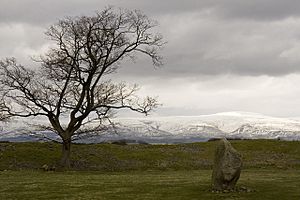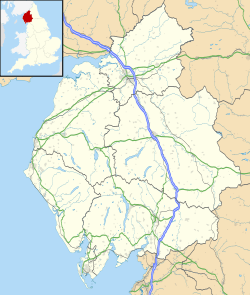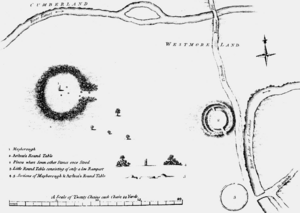Mayburgh Henge facts for kids

Mayburgh Henge, interior
|
|
| Location | Eamont Bridge |
|---|---|
| Coordinates | 54°38′56″N 2°44′48″W / 54.64889°N 2.74655°W |
| Type | Henge |
| History | |
| Periods | Neolithic / Bronze Age |
| Site notes | |
| Ownership | English Heritage |
| Public access | Yes |
Mayburgh Henge is a huge ancient monument in Cumbria, northern England. It's a special type of circular earthwork called a henge. This amazing site is looked after by English Heritage. It's also a protected historical place. Mayburgh Henge is only about 400 metres away from another famous henge, King Arthur's Round Table Henge.
Contents
Where is Mayburgh Henge?
Mayburgh Henge is found on a small hill. It is just outside the village of Eamont Bridge. This spot is where the Rivers Eamont and Lowther meet.
The henge is about 1 mile south of Penrith. It is also very close to the M6 motorway.
Ancient people built these henges in places that were important. These areas often had steep valleys and fast-flowing rivers. Mayburgh Henge and King Arthur's Round Table were connected by a natural spring. This spring flowed into the River Eamont.
This area was also a busy meeting point for ancient travel routes. Paths came from places like Shap and Carlisle. Eamont Bridge was a natural crossing point for the two rivers. Many ancient sites, like stone circles and cairns, are found near these old routes.
How Was Mayburgh Henge Built?
Mayburgh Henge is made of a single circular bank. This bank might have been built using rounded stones from the nearby rivers. This is different from most other henge monuments. Usually, henges are made from earth dug out of a ditch.
There is no sign of a ditch at Mayburgh Henge. Experts believe the bank contains about 20,000 tons of stones. Many stones have been taken away over the years. Some people think the bank might have been made by shaping a natural mound of earth left by glaciers.
The bank is very tall, up to 15 feet (6.5 metres) high. It is also very wide, about 50 metres across its base. The whole circle is about 383 feet (117 metres) wide.
Inside the henge, there is one tall stone. It stands about 9 feet (2.8 metres) high. In the early 1700s, there might have been more stones. Some old drawings show four stones in the middle. They also show four stones at the entrance.
One writer in 1773 said that local people remembered two other stones. These stones were similar to the one still standing. They were removed because they were "hurtful to the ground." It's possible the site was once a stone circle that was later changed. The large bank might have been added later.
The main entrance faces east. This direction lines up with where the sun rises during the spring and autumn equinoxes. This suggests the monument was built to observe the sun's movements. Other stone circles like Long Meg and Castlerigg also face east. From inside Mayburgh, you can see the ridge of Blencathra mountain. This is where the equinox sun sets.
When Was Mayburgh Henge Built and Why?
No full digging (excavation) has been done at Mayburgh. So, it's hard to know exactly when it was built. But ancient axes from the Neolithic (New Stone Age) and Bronze Age have been found nearby. This suggests it was built during one of those times. In 1992, a special survey was done. It used magnets to look for stones or ditches underground.
We don't know for sure why Mayburgh Henge was built. But its location near two rivers gives us some ideas. One idea is that it was a trading centre. It might have been on a route for stone axes. These axes came from a factory at Langdale.
Being close to a river and a spring also suggests it was used for special ceremonies. Many ancient monuments near water were used for rituals about life and death. For example, sites like Durrington Walls and Stonehenge also have links to water. The spring might have been important for rituals about new life.
The stones used in the henge have different colours. There are pink, blue-grey, and white quartz stones. This mix of colours would have made the henge look amazing. Using these coloured stones might have been symbolic. It could have linked the world of the living and the dead. This might have been done through rituals involving the sun, moon, and water. Similar coloured stones are found at Long Meg and Oddendale.
Mayburgh Henge's alignment with the equinox sun also points to it being used for astronomy. It might have helped people track the seasons, much like Long Meg.
Other Ancient Sites Nearby
Mayburgh Henge is part of a group of ancient sites in the area. Here are some of them:
- King Arthur's Round Table Henge: This henge is only 400 metres from Mayburgh Henge.
- Little Round Table: This henge was 75 metres south of King Arthur's Round Table. It cannot be seen today.
These three sites (Mayburgh Henge, King Arthur's Round Table, and Little Round Table) are sometimes called the "Penrith Henges."
Other important prehistoric sites:
- Shap Stone Avenue: About 10 miles south of Penrith.
- Long Meg and Her Daughters: About 6 miles northeast of Penrith.
Later historical sites:
- Brocavum Roman Camp: A Roman fort near Brougham.
- Brougham Castle: A medieval castle.
- Shap Abbey: An old abbey near Shap.
In the year 2000, a large granite stone was placed nearby. It is called the "Millennium Stone."





